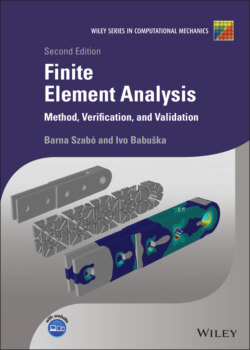Читать книгу Finite Element Analysis - Barna Szabó - Страница 51
1.8 Other finite element methods
ОглавлениеUp to this point we have been concerned with the finite element method based on the generalized formulation, called the principle of virtual work. There are many other finite element methods. All finite element methods share the following attributes:
1 Formulation. A bilinear form is defined on the normed linear spaces X, Y (i.e. , ) and the functional is defined on Y. The exact solution lies in X and satisfies:(1.151) The normed linear spaces, , the linear functional F and the bilinear form B satisfy the respective properties listed in sections A.1.1 and A.1.2.
2 Finite element spaces. The finite‐dimensional subspaces , () are defined and it is assumed that there are such that the sequence of functions ûi () converges in the space X to , that is:(1.152) The functions ûi are not the finite element solutions in general.
3 The finite element solution. The finite element solution satisfies:(1.153)
4 The stability criterion. The finite element method is said to be stable if(1.154) for all possible . The necessary and sufficient condition for a finite element method to be stable is that for every there is a so that(1.155) where is a constant, independent of i, or for every there is a so that this inequality holds. This inequality is known as the Babuška‐Brezzi condition, usually abbreviated to “the BB condition”. This condition was formulated by Babuška in 1971 [9] and independently by Brezzi in 1974 [29].
If the Babuška‐Brezzi condition is not satisfied then there will be at least some for which as even though there may be for which as . Examples are presented in [6]. In general it is difficult, or may even be impossible, to separate those for which the method works well from those for which it does not. The Babuška‐Brezzi condition guarantees that the condition number of the stiffness matrix will not become too large as i increases.
Remark 1.15 Any implementation of the finite element method must be shown to satisfy the Babuška‐Brezzi condition otherwise there will be some input data for which the method will fail even though it may work well for other input data. The formulation based on the principle of virtual work satisfies the Babuška‐Brezzi condition.
Exercise 1.23 Show that the finite element method based on the principle of virtual work satisfies the Babuška‐Brezzi condition.
